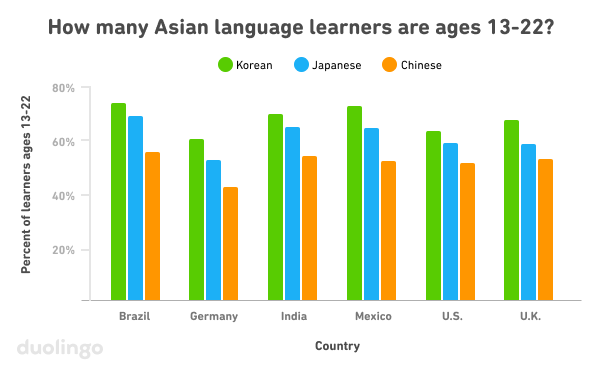Japanese, Korean, and Chinese are some of the most popular languages on Duolingo, and learners of these languages are passionate, too! They're especially driven by culture, music, and entertainment: For example, Squid Game inspired a new wave of Korean learners, and anime has long been a motivator for learning Japanese. But when it comes to studying Asian languages, how do learners around the world compare?
To learn more, we investigated learners and learning patterns in 6 of our biggest markets: Brazil, Germany, India, Mexico, the U.S., and the U.K. (We excluded Japan, Korea, and China, since the reasons people study Asian languages there might be quite different.)
Here's what we found!
India is the country most interested in Asian languages
Asian languages are extremely popular around the world, from Latin America to Asia to Europe! In all 6 countries, Japanese and Korean both rank in the top 10 most popular languages to study, and all 3 are in the top 10 in India, Mexico, and the U.S. Japanese generally ranks ahead of Korean, except in India and Mexico where Korean is the most popular Asian language.
In some ways, learners in India surpass their peers: Japanese, Korean, and Chinese all rank among the top 10 languages there, and Korean and Japanese are among the top 5. In fact, Korean has grown 75% year-over-year in India.
U.S. learners are next behind India, with all 3 languages ranking in the top 8—Japanese even makes it to #4!
Fun and family draw learners to Asian languages
There's another way Asian language learners are different from learners of other languages: their motivations! "Just for fun" is the #1 motivation of Asian language learners in Germany and India, and this reason is also #1 for Japanese and Korean learners in the U.S. and the U.K.
Studying to communicate with family or to connect with their heritage is the #1 reason that Chinese learners in Brazil, the U.S., and the U.K., study the language. Family is also the #1 reason that Brazilians study Japanese—this pattern is noteworthy because there are over 2.5 million Brazilians with Japanese ancestry!
There are 2 major outliers when we analyze the motivation data of Duolingo's Asian language learners. First, to spend time productively is the top reason that Mexicans study Japanese, Korean, and Chinese. Second, Korean learners in Brazil are primarily motivated by travel. While travel is a popular reason for many Asian language learners, no group is as serious about it as Brazilians studying Korean!
Korean learners are younger than other Asian language learners
Around the world, Korean language learners are younger than those studying Japanese and Chinese. On average, Japanese learners are a bit older than Korean learners, and Chinese learners trend older than learners of Korean and Japanese.
This pattern is especially true in Brazil, India, and Mexico, where at least 70% of learners are between 13 and 22. In fact, 47% of Korean learners in Brazil are between the ages of 13 and 17!

Japanese learners are the most serious
In all 6 countries, Japanese learners spend more time studying daily compared to learners of Korean or Chinese—and Japanese students in Germany far outpace their peers in the U.K. (#2) and the U.S. (#3).
And here’s something cool: Japanese learners have something in common with learners in Japan—both groups are serious about studying! That’s right: Those in Japan are the most serious learners in the world! Learners studying Japanese are clearly a good match for their target culture.
There's more to explore
To learn more about the latest Asian language trends and the newest improvements to our Asian language courses, tune in to Duocon, our annual conference on learning through technology! Duocon will be broadcast live online on October 11, 2023. Learn more at the Duocon website!



